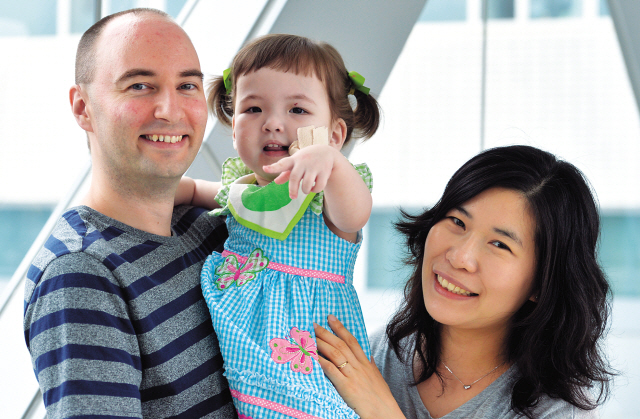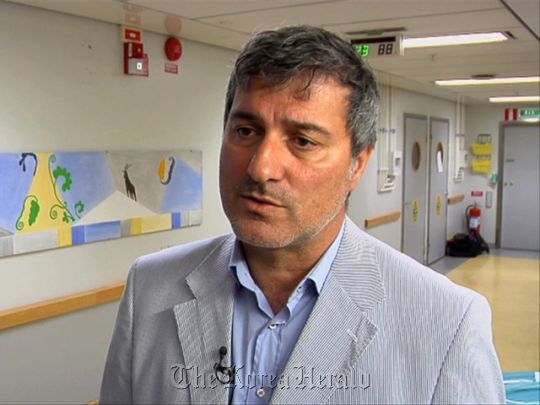Hannah, 2, awaiting groundbreaking procedure for windpipe
The sight of Lee Young-mi leading her nearly 2-year-old daughter Hannah along a hallway in Seoul National University Hospital might not sound too unusual.
But when The Korea Herald visited her about one year ago, she could do nothing but lie on her back. Hannah can now walk if she holds on to her parents’ hands, though she can’t go far.
Hannah was born without a windpipe. Because she needs to have her artificial airway cleared every fifteen minutes or so she has never left the hospital building.
The second daughter of Lee Young-mi and Darryl Warren, Hannah Warren was born at Dongguk University Ilsan Hospital in Goyang-si, Gyeonggi Province on Aug. 22, 2010.
“Hannah was having difficulty breathing, and the medical team could not tell what was wrong with her. When the team looked through laryngoscope, they realized Hannah did not have a trachea,” said Lee Joo-young, Hannah’s current attending physician at Seoul National University Children’s Hospital.
“Hannah has an air passageway that connects to the artificial windpipe, but there was a huge chance of infections or lung damage. The hospital predicted her life expectancy to be less than two months when she was born,” said Lee Young-mi. Contrary to expectations, Hannah will be celebrating her second birthday in August.
“We hope to spend Hannah’s second birthday in the United States,” Lee added. Hannah’s parents plan to take the little girl to the U.S. for her new trachea as soon as necessary procedures are completed.
“We were about to give up everything when Lindsay Sohn, a Korean-American nurse from the States, suggested Hannah be treated in the United States,” said Lee.
The sight of Lee Young-mi leading her nearly 2-year-old daughter Hannah along a hallway in Seoul National University Hospital might not sound too unusual.
But when The Korea Herald visited her about one year ago, she could do nothing but lie on her back. Hannah can now walk if she holds on to her parents’ hands, though she can’t go far.
Hannah was born without a windpipe. Because she needs to have her artificial airway cleared every fifteen minutes or so she has never left the hospital building.
The second daughter of Lee Young-mi and Darryl Warren, Hannah Warren was born at Dongguk University Ilsan Hospital in Goyang-si, Gyeonggi Province on Aug. 22, 2010.
“Hannah was having difficulty breathing, and the medical team could not tell what was wrong with her. When the team looked through laryngoscope, they realized Hannah did not have a trachea,” said Lee Joo-young, Hannah’s current attending physician at Seoul National University Children’s Hospital.
“Hannah has an air passageway that connects to the artificial windpipe, but there was a huge chance of infections or lung damage. The hospital predicted her life expectancy to be less than two months when she was born,” said Lee Young-mi. Contrary to expectations, Hannah will be celebrating her second birthday in August.
“We hope to spend Hannah’s second birthday in the United States,” Lee added. Hannah’s parents plan to take the little girl to the U.S. for her new trachea as soon as necessary procedures are completed.
“We were about to give up everything when Lindsay Sohn, a Korean-American nurse from the States, suggested Hannah be treated in the United States,” said Lee.

Dr. Mark Holterman, pediatrics division chief at the University of Illinois Medical Center in Chicago, visited Korea to meet with Hannah and her parents in April 2011.
“He was determined to save Hannah’s life. He promised to find a doctor in the trachea transplant field. It was such a rare opportunity and we were fortunate.”
That is how Hannah’s parents were introduced to Dr. Paolo Macchiarini, the doctor who performed the world’s first stem cell-based tracheal transplant surgery in November 2008. Less than a handful of patients have undergone this groundbreaking surgery so far.
“Hannah has no native trachea and we do not know how much her larynx is developed. She is therefore breathing through a tube that from her mouth goes to the lung passing via the esophagus. The rationale for the operation would be to create a new trachea so that she can breathe on her own and have a normal life,” explained Macchiarini, professor of regenerative medicine at Karolinska Institute in Stockholm, in an email about the upcoming operation.

Hannah’s surgery is currently waiting FDA approval, as it will involve stem cells that are being used for this type of procedure for the first time.
“This is the first time that I am doing this at this age. This type of congenital abnormalities results, in 99 percent of cases, in death within the first year of life. Hannah is a beautiful child that has all the right to live, and if there is only one chance that we may help her, then we will do it,” said Macchiarini.
“Countless people have helped Hannah. I don’t even know some of their names, but it was such a great comfort,” Lee Young-mi said. Lee and Warren have been able to receive funds through Seoul National University Children’s Hospital and Sarangbat Letter foundation.
“Through exposure to online communities and the press media, we have been able to raise more than 1 billion won for Hannah’s upcoming surgery,” said Bae Sung-geun, Sarangbat Letter’s assistant administrator. “Many of the foundation’s members are mothers who have children around Hannah’s age. One supporter sent toys and clothes along with a long letter saying that she thinks of Hannah as her own daughter,” added Bae.
Another strong pillar of support are the nurses and doctors, whom Warren calls “the blue angels.”
“Being around all the nurses is one of the reasons that we’re so lucky. They have been so good to Hannah,” said Warren.
“Actually, a baby as big as Hannah has never been hospitalized in our neonatal care unit. The babies usually get better after two or three months, but Hannah held her first birthday party in this ward. She needs a lot of care and attention from the nurses, but she is so lovely that the nurses are very nice to her,” said Lee Joo-young.
Hannah, however, has not always been this lucky. In the less than two years of her short life, she has pulled out of many potentially life-threatening situations.
“Hannah contracted pneumonia numerous times. Because she does not have a trachea, the medical team has disconnected her esophagus from her stomach and connected it to the airway. An esophagus secretes mucous often and the secretion sometimes flows toward the lung, which causes an infection even when the medical team suctions out the secretion constantly,” explained Lee Joo-young.
Hannah’s condition has also hindered her from developing like other infants.
“Three months after birth, infants can usually flip. After nine months, they can stand up. But all Hannah could do for over a year was to stare at the ceiling with her ventilator,” said Lee Joo-young. Hannah depended on an artificial respirator for the first six months of her life, from her birth to February 2011. She then received oxygen treatment for another six months. “She’s much better now. She has strength in her legs, and she can even walk a little,” added Lee. “When she’s doing her physiotherapy, she’s trying very hard. Her development is obviously slower, compared to kids her age, but she’s doing really well,” said Warren.
“When we started this we thought we were very unlucky and unhappy. But, we soon found out that with all the support we’ve gotten, and how she fought through this, everything has turned into a very positive frame of mind. And now it’s just waiting for her to get better. We hope that happens soon.”
By Jennifer Ryu, Intern reporter (jjr378@nyu.edu)
-
Articles by Korea Herald


![[AtoZ into Korean mind] Humor in Korea: Navigating the line between what's funny and not](http://res.heraldm.com/phpwas/restmb_idxmake.php?idx=644&simg=/content/image/2024/04/22/20240422050642_0.jpg&u=)
![[Exclusive] Korean military set to ban iPhones over 'security' concerns](http://res.heraldm.com/phpwas/restmb_idxmake.php?idx=644&simg=/content/image/2024/04/23/20240423050599_0.jpg&u=20240423183955)



![[Graphic News] 77% of young Koreans still financially dependent](http://res.heraldm.com/phpwas/restmb_idxmake.php?idx=644&simg=/content/image/2024/04/22/20240422050762_0.gif&u=)
![[Herald Interview] Why Toss invited hackers to penetrate its system](http://res.heraldm.com/phpwas/restmb_idxmake.php?idx=644&simg=/content/image/2024/04/22/20240422050569_0.jpg&u=20240422150649)






![[Exclusive] Korean military to ban iPhones over security issues](http://res.heraldm.com/phpwas/restmb_idxmake.php?idx=652&simg=/content/image/2024/04/23/20240423050599_0.jpg&u=20240423183955)



![[Today’s K-pop] Ateez confirms US tour details](http://res.heraldm.com/phpwas/restmb_idxmake.php?idx=642&simg=/content/image/2024/04/23/20240423050700_0.jpg&u=)